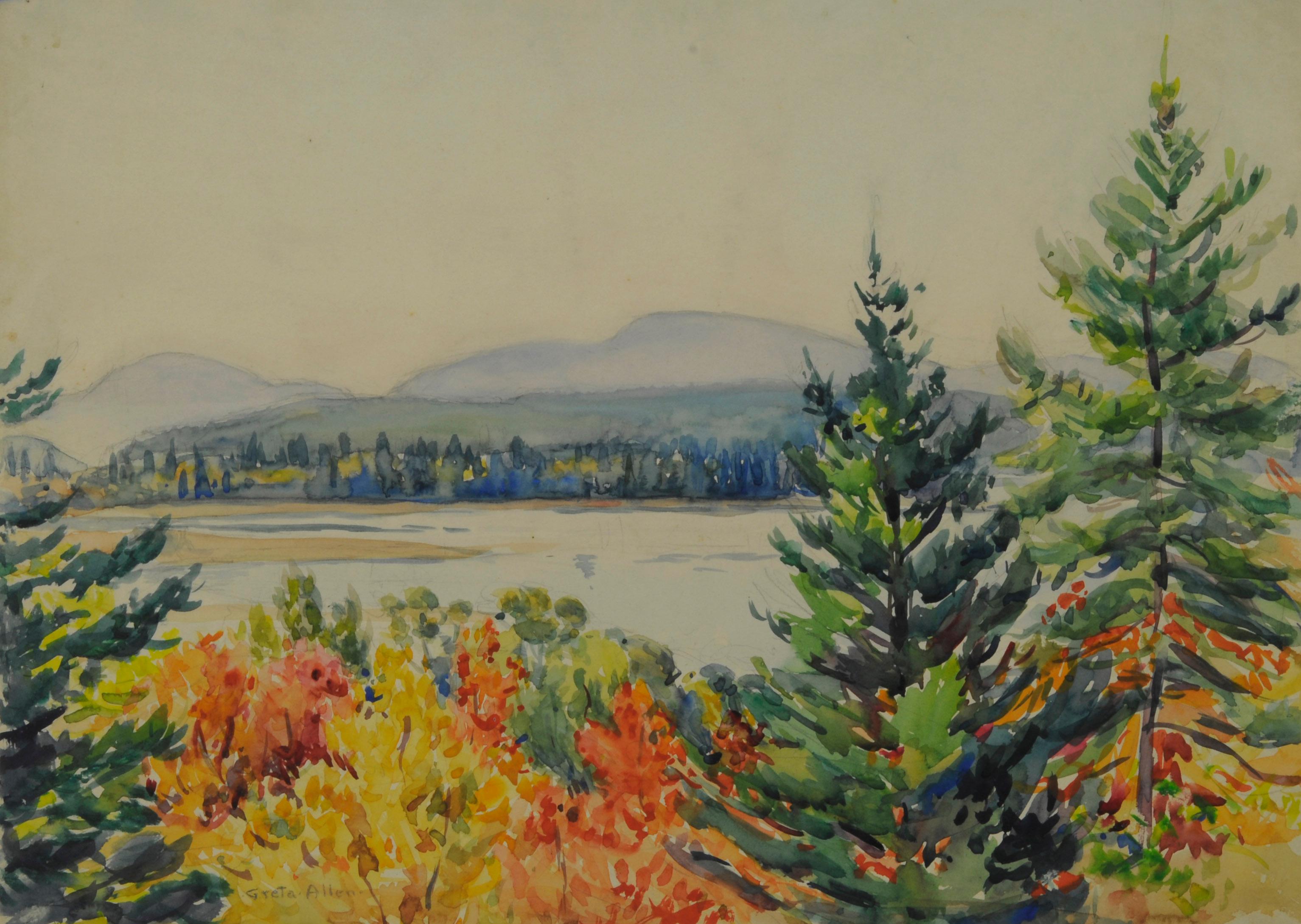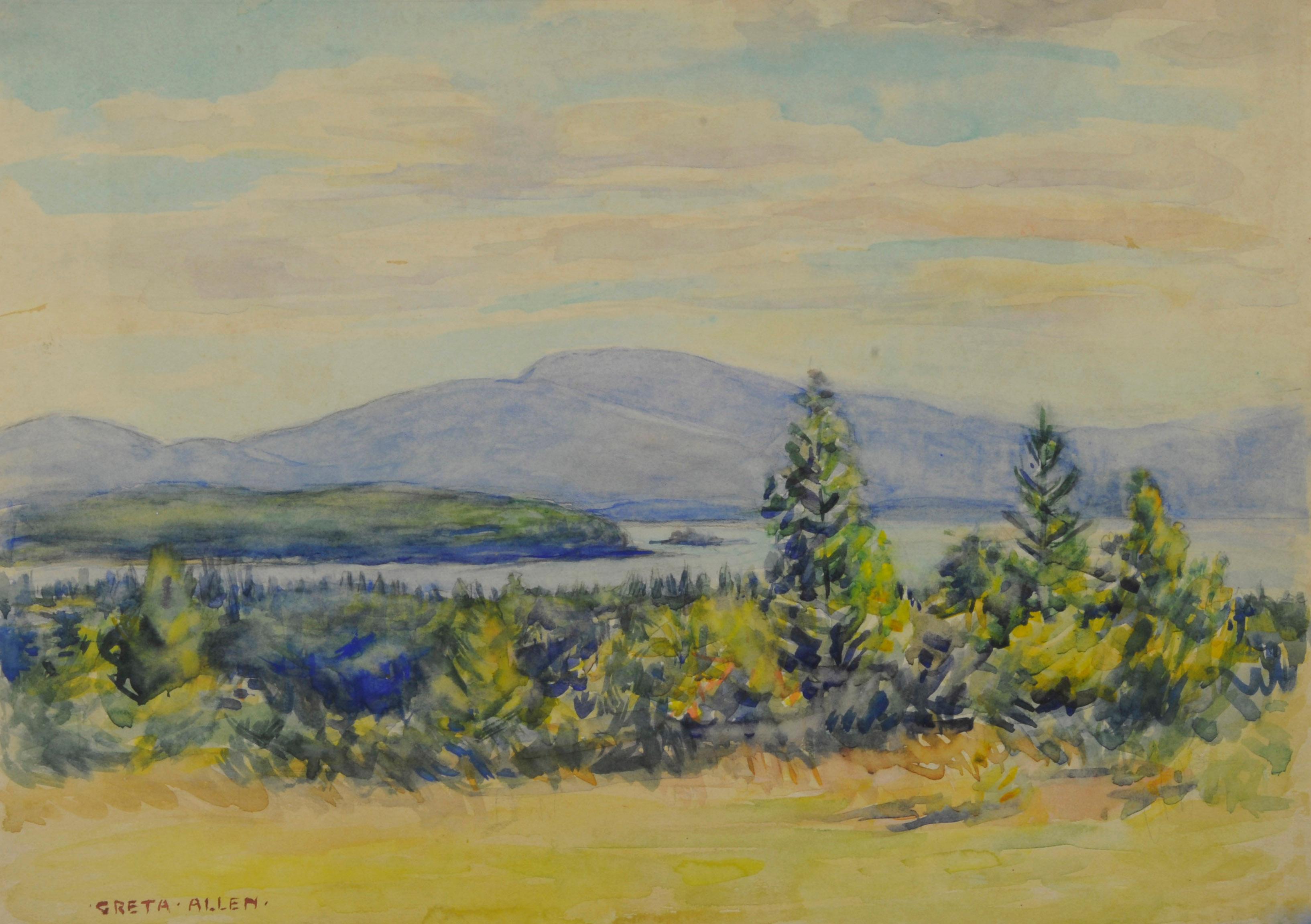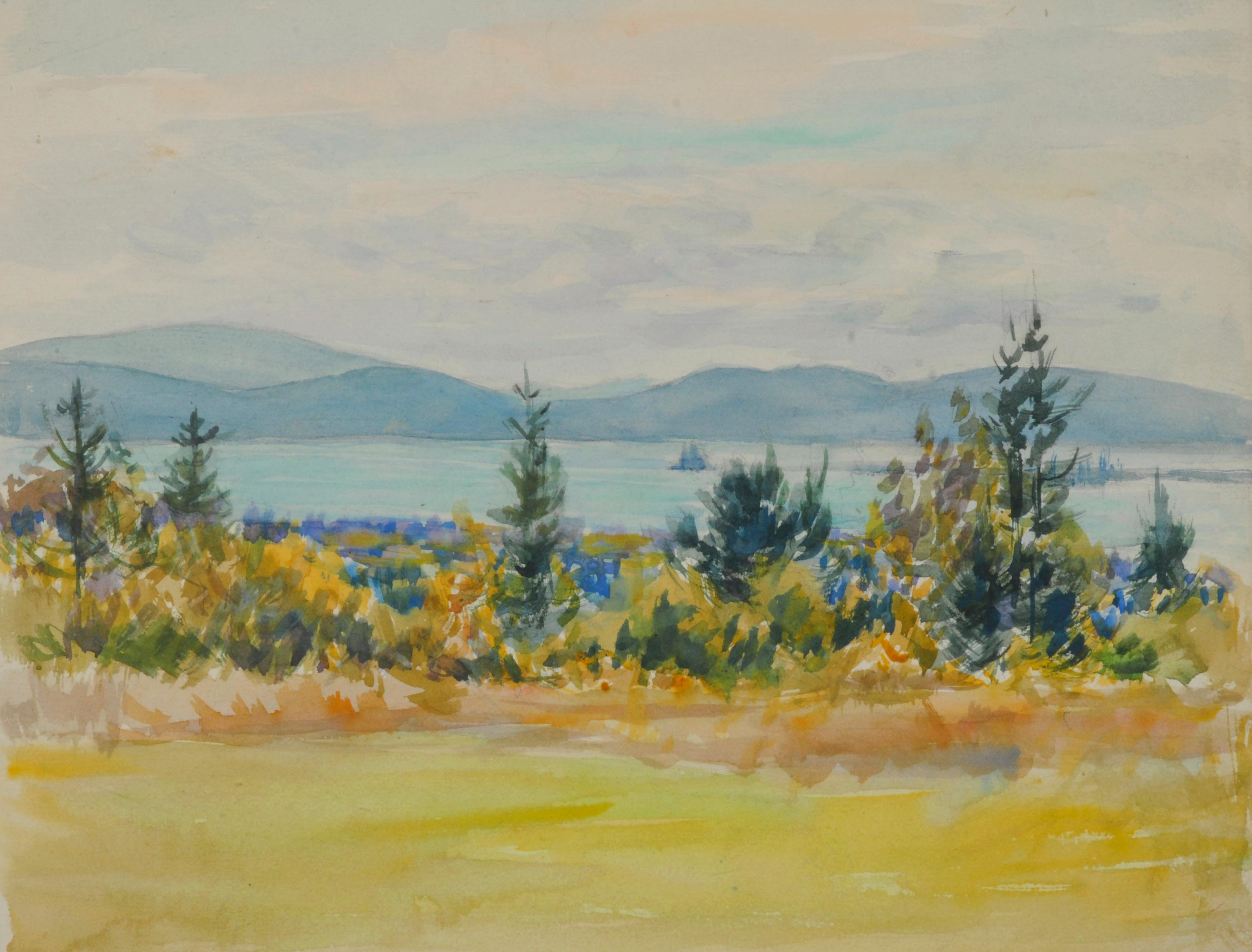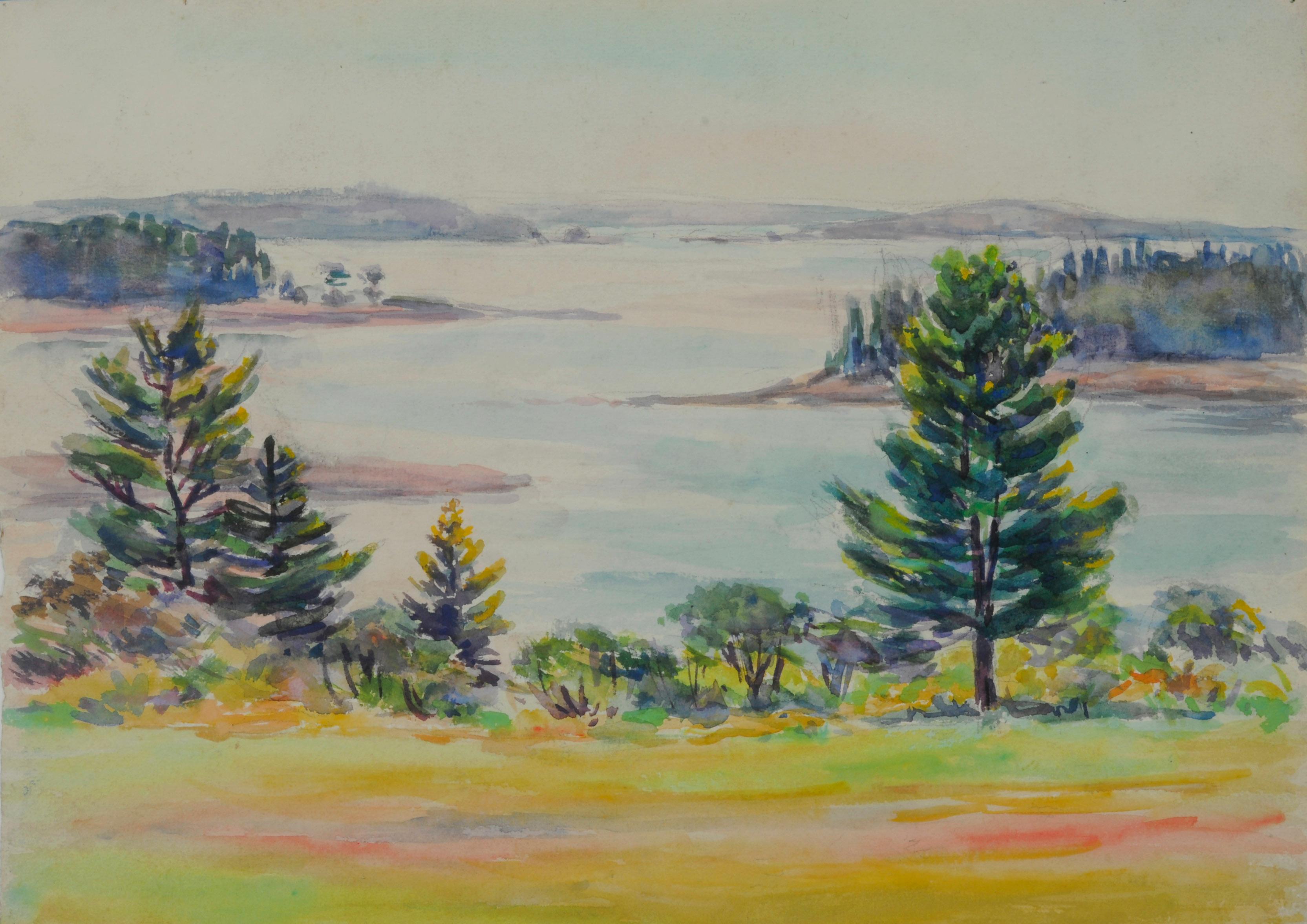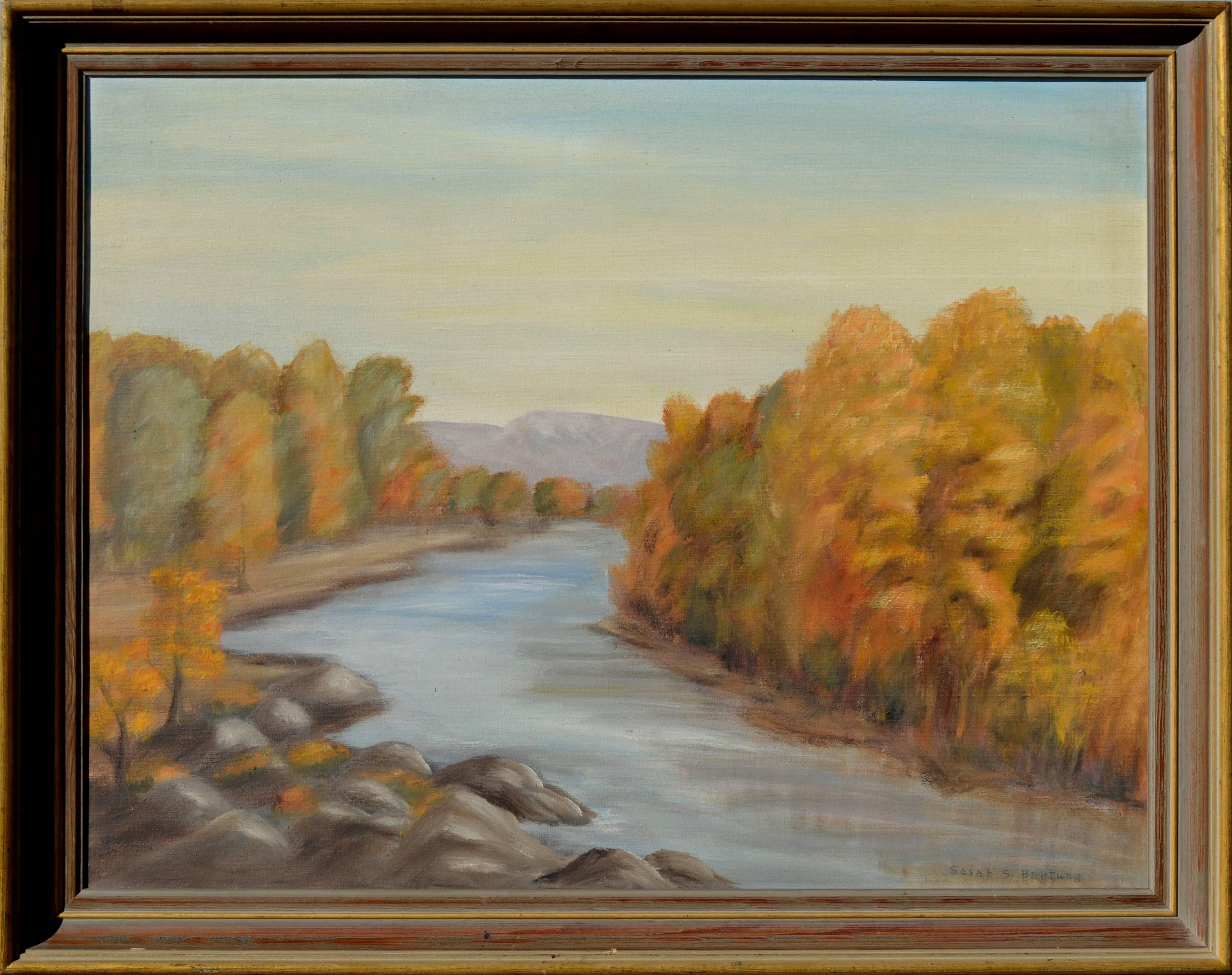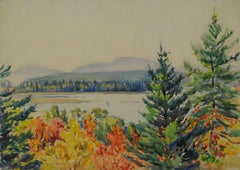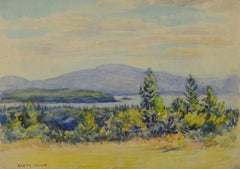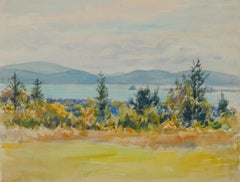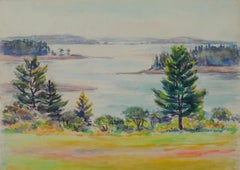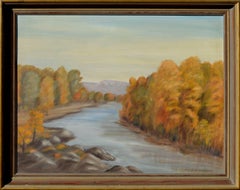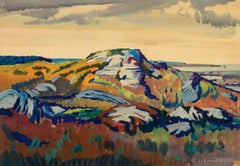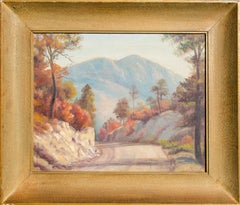Items Similar to untitled (Maine Autumn Landscape across the narrows from Mt. Desert)
Want more images or videos?
Request additional images or videos from the seller
1 of 11
Greta Allenuntitled (Maine Autumn Landscape across the narrows from Mt. Desert)1945-1955
1945-1955
$1,800
£1,359.29
€1,556.26
CA$2,542.07
A$2,775.33
CHF 1,454.99
MX$33,707.48
NOK 18,170.50
SEK 17,157.79
DKK 11,615.82
About the Item
untitled (Maine Autumn Landscape across the narrows from Mt. Desert)
Watercolor, 1945-1955
Signed by the artist lower left in pencil (see photo)
Provenance: Estate of the artist
Condition: Excellent
Image/Sheet size: 14 1/4 x 19 5/8 inches
Regarding the Maine subject matter of her watercolors, we know that Allen taught art in West Gouldsboro, ME, located near Arcadia National Forest. This watercolor was most probably done in that vicinity.
A local Maine newsletter mentions “the artist Greta Allen’s house” as artist residing in West Gouldsboro, Maine in a house formerly owned by James Hill. West Gouldsboro is located just east of the Mt. Desert Narrows, across Frenchman Bay from Mt. Desert Island and Arcadia National Park.
Please read the attached jpgs with a detail narrative of Allen's life and her time in Maine.
Greta Allen, who is sometimes listed under her married name Dietz, was born in Boston in 1881. At the Massachusetts Normal Art School she took elementary lessons from Joseph R. DeCamp, then Frank Benson was her teacher at the School of the Museum of Fine Arts, Boston. Although her work seems to be only in private collections today, Allen exhibited at the Boston Art Club, at the Copley Society and at the Boston Society of Arts and Crafts between 1897 and 1927. Her Portrait of a Boy was featured at the Pennsylvania Academy's annual exhibition of 1918.
Allen, who eventually taught art, had a solo show in 1930 in Milwaukee. The style of her genteel images relates to that of her teacher Benson. Allen was also a talented watercolor painter and we know that she worked at some point in Provincetown. Two works by Allen are in the Louise and Allan Sellars Collection (See Art by American Women: Selections from the Collection of Louise and Allan Sellars. Exh. cat. Gainesville, GA: Brenau College, 1991, p. 15).
Written and submitted by Michael Preston Worley, Ph.D.
(Courtesy of askART)
- Creator:Greta Allen (1881 - 1921, American)
- Creation Year:1945-1955
- Dimensions:Height: 14.25 in (36.2 cm)Width: 19.63 in (49.87 cm)
- Medium:
- Movement & Style:
- Period:
- Condition:
- Gallery Location:Fairlawn, OH
- Reference Number:Seller: FA65681stDibs: LU14013527392
About the Seller
5.0
Recognized Seller
These prestigious sellers are industry leaders and represent the highest echelon for item quality and design.
Platinum Seller
Premium sellers with a 4.7+ rating and 24-hour response times
Established in 1978
1stDibs seller since 2013
814 sales on 1stDibs
Typical response time: <1 hour
Associations
International Fine Print Dealers Association
- ShippingRetrieving quote...Shipping from: Fairlawn, OH
- Return Policy
Authenticity Guarantee
In the unlikely event there’s an issue with an item’s authenticity, contact us within 1 year for a full refund. DetailsMoney-Back Guarantee
If your item is not as described, is damaged in transit, or does not arrive, contact us within 7 days for a full refund. Details24-Hour Cancellation
You have a 24-hour grace period in which to reconsider your purchase, with no questions asked.Vetted Professional Sellers
Our world-class sellers must adhere to strict standards for service and quality, maintaining the integrity of our listings.Price-Match Guarantee
If you find that a seller listed the same item for a lower price elsewhere, we’ll match it.Trusted Global Delivery
Our best-in-class carrier network provides specialized shipping options worldwide, including custom delivery.More From This Seller
View Alluntitled (Maine Autumn Landscape across the narrows from Mt. Desert)
By Greta Allen
Located in Fairlawn, OH
untitled (Maine Autumn Landscape across the narrows from Mt. Desert)
Watercolor, 1945-1955
Signed by the artist lower left in pencil (see photo)
Provenance: Estate of the artist
Cond...
Category
1940s American Impressionist Landscape Drawings and Watercolors
Materials
Watercolor
untitled (Maine Landscape near Mt. Desert Island)
By Greta Allen
Located in Fairlawn, OH
untitled (Maine Landscape near Mt. Desert Island)
Watercolor on paper, c. 1945-1955
Signed by the artist lower left (see photo)
Provenance: Estate of the artist
Condition: Excellent
...
Category
1940s American Impressionist Landscape Drawings and Watercolors
Materials
Watercolor
West Gouldsboro (Looking Across Mt. Desert Narrows)
By Greta Allen
Located in Fairlawn, OH
West Gouldsboro (Looking Across Mt. Desert Narrows)
Watercolor on paper, c. 1945-1955
Unsigned
Provenance: Estate of the Artist
Condition: Excellent
Image/Sheet size: 9 7/8 x 12 1/2 inches
Regarding the Maine subject matter of her watercolors, we know that Allen taught art in West Gouldsboro, ME, located near Arcadia National Forest. This watercolor was most probably done in that vicinity.
A local Maine newsletter mentions “the artist Greta Allen’s house” as artist residing in West Gouldsboro, Maine in a house formerly owned by James Hill. West Gouldsboro is located just east of the Mt. Desert Narrows, across Frenchman Bay from Mt. Desert Island and Arcadia National Park.
Please see attached images for detailed information about the artist's life and time in Maine.
Greta Allen, who is sometimes listed under her married name Dietz, was born in Boston in 1881. At the Massachusetts Normal Art School she took elementary lessons from Joseph R. DeCamp, then Frank Benson was her teacher at the School of the Museum of Fine Arts, Boston. Although her work seems to be only in private collections today, Allen exhibited at the Boston Art Club, at the Copley Society...
Category
1940s American Impressionist Landscape Drawings and Watercolors
Materials
Watercolor
untitled (Mt. Desert Narrows)
By Greta Allen
Located in Fairlawn, OH
untitled (Mt. Desert Narrows)
Watercolor on paper, c. 1945-1955
Unsigned
Provenance: Estate of the Artist
Condition: Excellent
Image/sheet size: 11 1/4 x 15 3/8 inches
Regarding the ...
Category
1940s American Impressionist Landscape Drawings and Watercolors
Materials
Watercolor
On-coming Tide, Winter Harbor, Maine
Located in Fairlawn, OH
On-coming Tide, Winter Harbor, Maine
Oil on artist's board, 1971
Signed lower right
Signed, titled, and dated verso
Provenance: Estate of the Artist
Condition: Excellent
Need a ...
Category
1970s American Impressionist Landscape Paintings
Materials
Oil
Autumn Landscape
By Royal Milleson
Located in Fairlawn, OH
Autumn Landscape
Oil on relined canvas, c. 1915
Signed lower right corner: "Royal H. Milleson"
Condition: Excellent
Canvas size: 14 1/2 x 20 3/8 inches
Frame size: 19-1/4 x 25-1/4 x 2-1/2 inches
Clearly among the artist's finest paintings!
Provenance: Private Collection, Greencastle, Indiana
Ray H. French Collection (1919-2000)
Martha A. French Trust
Royal Hill Milleson...
Category
1910s American Impressionist Landscape Paintings
Materials
Oil
You May Also Like
Eve Nethercott, "Fall", New England Landscape
By Eve Nethercott
Located in Long Island City, NY
Fall (P6.8)
Eve Nethercott
American (1925–2015)
Date: 1951
Watercolor on Paper
Size: 18 x 22 in. (45.72 x 55.88 cm)
Category
1950s American Impressionist Landscape Drawings and Watercolors
Materials
Watercolor
Autumn Trees - Mid Century Landscape
By Sarah S. Hartung
Located in Soquel, CA
A beautiful autumn landscape with river reflecting the blue sky by Sarah S. Hartung (American, 20th Century). Signed "Sarah S. Hartung" lower right. Giltwood frame. Image, 21.25"H x ...
Category
1950s American Impressionist Landscape Paintings
Materials
Canvas, Oil
$680 Sale Price
20% Off
View Towards Christmas Cove, Maine, Early 20th Century East Coast Landscape
By Frank Wilcox
Located in Beachwood, OH
View Towards Christmas Cove, Maine, c. 1923
Watercolor on paper
Signed lower right
14 x 19.5 inches
Frank Nelson Wilcox (October 3, 1887 – April 17, 1...
Category
1920s American Modern Landscape Drawings and Watercolors
Materials
Watercolor
Autumn Landscape Painting Signed by W.E. Beatty
Located in New York, NY
W.E. Beatty
Untitled (Autumn Landscape), c. 20th century
Oil on canvas
16 x 20 in.
Framed: 22 1/2 x 26 1/2 in.
Signed lower right: W E BEATTY
Category
20th Century American Impressionist Landscape Paintings
Materials
Oil
Autumn by the River - Landscape
Located in Soquel, CA
Serene landscape by J. B. Schock. Several trees line the banks of a river, bursting with fall colors. Across the river on the far bank, the roof and chimneys of a house can be seen beyond the trees. California painter...
Category
Early 20th Century American Impressionist Landscape Drawings and Waterco...
Materials
Watercolor, Laid Paper
"Autumn" Colorful Mid-20th Century American Oil Painting Landscape with Tress
Located in New York, NY
A wonderful depiction of an Autumn landscape in Kent, Connecticut from the Mid-20th Century with puffed trees by the country side. For this beautiful depiction, we find distinct elements that are unique to the earlier works of George Lawrence...
Category
1950s American Impressionist Landscape Paintings
Materials
Oil, Board, Canvas
